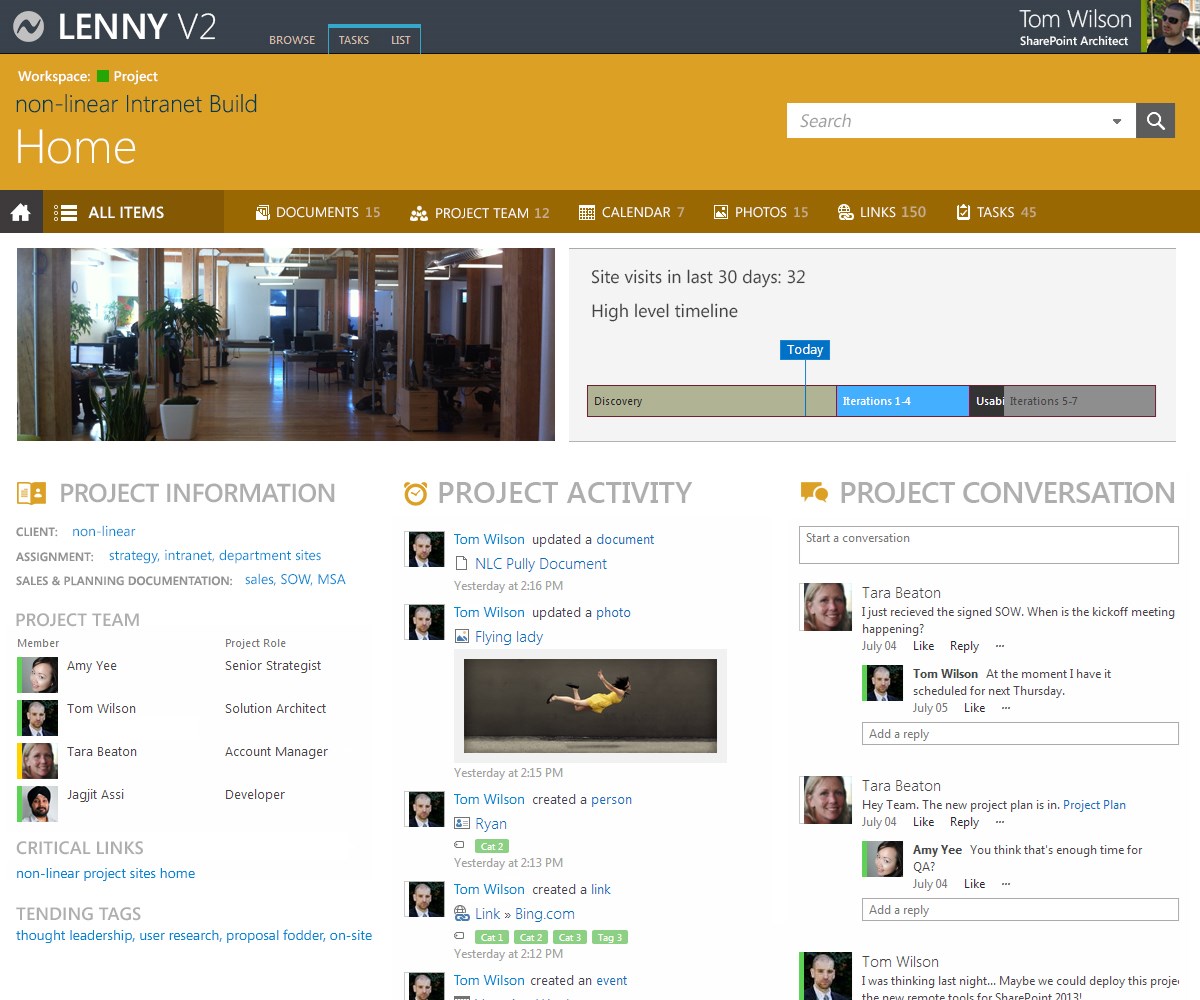outubro 08, 2013
The best way to determine whether a technology platform is performing admirably is to see in the real world. We provide multiple first hand experiences of driving business value using SharePoint.
Our immersion in the enterprise space as consultants often leads us to forget that not everyone we come in contact with will know or appreciate the benefits of a well-designed intranet solution. The success of a great intranet lies in a scalable technology solution that supports the business needs of an organization. A successfully intranet is only possible if both the business and technology departments are aware of the capabilities of the technology and how it help meet business objectives in an organization.
Unfortunately, that is very rarely the case. Take for example this scenario which we’ve come across often: IT has acquired and deployed within the organization an instance of SharePoint. For the most part, users have been trained to use SharePoint as a glorified file share system. It is possible that the more adventurous types collaborate and use some of the software’s more “complex” features, but these are exceptions to the rule. In the end, what you have is IT knowing a lot about maintaining the application, with little knowledge as to the benefits of SharePoint that could be passed on to their business co-workers.
To bridge this disconnect we will highlight a few of our projects that have combined business drive objectives with strong SharePoint technology:
Human resources
Automated workflow processes can make on-boarding a breeze
In one project, we were asked by Human Resources to look at their new employee on-boarding procedure to see if we could improve its efficiency and flexibility to decrease administrative time and effort and increase productivity. Their current system relied too heavily on emails to multiple recipients, was prone to errors and duplication and took several days to process one request.
Taking advantage of our client’s SharePoint investment, Valtech designed a solution that is now owned by the business unit with little involvement from IT. The new program works in such a way that as new recruits are hired, a form-based process triggers a number of workflows that automatically populates the HR and payroll systems, as well as simultaneously provisions for IT, so that systems credentials are created and equipment is set and configured for when the new recruit arrives on their first day of work. This new workflow process is supported by a SharePoint dashboard which keeps track of each steps of the new on-boarding system.
Distributed project team
SharePoint’s capabilities have the power to bring employees together
Many professional services organizations run projects with remote teams located in all corners of the world. Projects by their nature are complicated, and if you don’t have a system to organize and run them things can quickly get out of control. For the most part projects deal with resource scheduling, project planning, Gantt charts, documents, approvals sign offs and collaboration. These various types of content are not only shared with employees, but oftentimes with partners or clients as well. Our challenge was to find a way to securely share internal documents with these interested parties in a safe, secure and accessible way.
In response, Valtech has built project workspaces to act as a central location where anyone can visit to get the latest news, document and dates in an instant. It helps teams seamlessly collaborate across any distance, alleviating technological hurdles so members can focus on the when and where of a project instead of the how. We have rolled out project workspaces for some of Canada’s largest companies, and have helped teams with people in Calgary, Seattle and Montreal collaborate and innovate with as little effort as possible by leveraging SharePoint’s newest technology. The following screen shot demonstrates a typical and somewhat customized project workspace landing page:

As you can see entries under the “Project Information” umbrella shows information about a project and its team members. This knowledge is vital in avoiding the inevitable chase down of fellow co-workers when tasked with learning more about and contributing to a project.
The “Project Activity” section is likely to be deemed as the most helpful section of this workspace landing page. It provides the most relevant and timely information about any given project, allowing employees to stay in the know on all recent changes and offers one-click access to the most recently created or edited documents.
The final section “Project Conversations” is the ideal location for any individual within the project to highlight issues, with the added benefit of automatic feedback, encouraging collaboration between all members of the team.
You’ll also notice a Gantt chart in the top right section of the page, which displays the project’s milestones. Within the timeline, subtasks can be created to further organize your team. The project workspace navigation that spans across the page provides vital information about the number of items under each area. This alleviates the need to visit each area to deduce if work in that area has begun.
Sales division
Workflow processes that encourage full departmental collaboration
In one of our recent client engagements, we identified a major disconnect between their sales division, project management office and finance department. The problem was this: when new business closed, information discussed during the sales process was not communicated or simply omitted and never reached the project management office or finance department. The missing information forced project managers to chase down sales reps, causing delays in invoicing and collection, ultimately affecting the overall image of the organization.
Our solution consisted of a business process re-alignment supported by a native SharePoint application. The system relies on triggers initiated by the sales rep in the Customer Relationship Management (CRM) application they use on a daily basis. Information collected from the CRM system drives a number of intake forms that feed into the project management database and the company’s financial system. Incentive-based and data-validating rules ensure that data collected from the originating system is complete and accurate.
Since implementing this new system, the organization has improved its invoicing and collection methods as well as improving moral between the various groups.
Document findability
Enabling fast document retrieval can promote increased productivity
The ability to find documents within an organization is becoming increasingly difficult these days. For a lot of organizations, the shared “M” drive (or whatever lucky letter your company has chosen for you) is a jungle of folders structured in an archaic organizational structure, containing files with subjective naming schemes and ill-conceived metadata structure (if you’re fortunate to even have a corporate-wide metadata schema). It’s only a matter of time until people stop using it altogether and resort to their portable hard drive or personal cloud drive account; a recipe for corporate chaos.
At Valtech we’ve come up with a facilitated approach to help organizations put in place an effective enterprise search and document findability strategy for SharePoint. During our strategy engagement, a number of activities took place, including:
- A review of the current state of the organization’s document management approach
- Metadata discovery and workshop
- Governance review and recommendations
- Workflow and security / permission model
- Technical review
- End-user validation
- Solution deployment
The outcome of our work sets the foundation for a solid information management approach that raises the bar in user adoption by removing barriers for finding, storing, sharing, governing, accessing, and sending information within the organization.
The unique ability to drive business goals with innovative technology solutions like SharePoint is quickly becoming a benchmark for all organizations. There are numerous benefits to embracing this two-pronged approach to business success, including increased productivity, better collaboration and streamlined processes. Adoption is quickly becoming a question of not if, but when.





